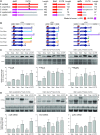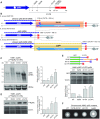Differential evolution in 3'UTRs leads to specific gene expression in Staphylococcus
- PMID: 32016395
- PMCID: PMC7049690
- DOI: 10.1093/nar/gkaa047
Differential evolution in 3'UTRs leads to specific gene expression in Staphylococcus
Abstract
The evolution of gene expression regulation has contributed to species differentiation. The 3' untranslated regions (3'UTRs) of mRNAs include regulatory elements that modulate gene expression; however, our knowledge of their implications in the divergence of bacterial species is currently limited. In this study, we performed genome-wide comparative analyses of mRNAs encoding orthologous proteins from the genus Staphylococcus and found that mRNA conservation was lost mostly downstream of the coding sequence (CDS), indicating the presence of high sequence diversity in the 3'UTRs of orthologous genes. Transcriptomic mapping of different staphylococcal species confirmed that 3'UTRs were also variable in length. We constructed chimeric mRNAs carrying the 3'UTR of orthologous genes and demonstrated that 3'UTR sequence variations affect protein production. This suggested that species-specific functional 3'UTRs might be specifically selected during evolution. 3'UTR variations may occur through different processes, including gene rearrangements, local nucleotide changes, and the transposition of insertion sequences. By extending the conservation analyses to specific 3'UTRs, as well as the entire set of Escherichia coli and Bacillus subtilis mRNAs, we showed that 3'UTR variability is widespread in bacteria. In summary, our work unveils an evolutionary bias within 3'UTRs that results in species-specific non-coding sequences that may contribute to bacterial diversity.
© The Author(s) 2020. Published by Oxford University Press on behalf of Nucleic Acids Research.
Figures








Similar articles
-
Bacterial 3'UTRs: A Useful Resource in Post-transcriptional Regulation.Front Mol Biosci. 2021 Jan 8;7:617633. doi: 10.3389/fmolb.2020.617633. eCollection 2020. Front Mol Biosci. 2021. PMID: 33490108 Free PMC article. Review.
-
Comparative genomic analysis of the 3' UTR of human MDM2 identifies multiple transposable elements, an RLP24 pseudogene and a cluster of novel repeat sequences that arose during primate evolution.Gene. 2020 May 30;741:144557. doi: 10.1016/j.gene.2020.144557. Epub 2020 Mar 20. Gene. 2020. PMID: 32171824
-
Patterns in interspecies similarity correlate with nucleotide composition in mammalian 3'UTRs.Nucleic Acids Res. 2003 Sep 15;31(18):5433-9. doi: 10.1093/nar/gkg751. Nucleic Acids Res. 2003. PMID: 12954780 Free PMC article.
-
3'UTRs take a long shot in the brain.Bioessays. 2014 Jan;36(1):39-45. doi: 10.1002/bies.201300100. Epub 2013 Sep 20. Bioessays. 2014. PMID: 24115048 Free PMC article. Review.
-
Formation, regulation and evolution of Caenorhabditis elegans 3'UTRs.Nature. 2011 Jan 6;469(7328):97-101. doi: 10.1038/nature09616. Epub 2010 Nov 17. Nature. 2011. PMID: 21085120 Free PMC article.
Cited by
-
Bioinformatics Analysis of the Interaction of miRNAs and piRNAs with Human mRNA Genes Having di- and Trinucleotide Repeats.Genes (Basel). 2022 Apr 29;13(5):800. doi: 10.3390/genes13050800. Genes (Basel). 2022. PMID: 35627185 Free PMC article.
-
Bacterial 3'UTRs: A Useful Resource in Post-transcriptional Regulation.Front Mol Biosci. 2021 Jan 8;7:617633. doi: 10.3389/fmolb.2020.617633. eCollection 2020. Front Mol Biosci. 2021. PMID: 33490108 Free PMC article. Review.
-
Siblings or doppelgängers? Deciphering the evolution of structured cis-regulatory RNAs beyond homology.Biochem Soc Trans. 2020 Oct 30;48(5):1941-1951. doi: 10.1042/BST20191060. Biochem Soc Trans. 2020. PMID: 32869842 Free PMC article. Review.
-
Leishmania Ribosomal Protein (RP) paralogous genes compensate each other's expression maintaining protein native levels.PLoS One. 2024 May 16;19(5):e0292152. doi: 10.1371/journal.pone.0292152. eCollection 2024. PLoS One. 2024. PMID: 38753846 Free PMC article.
-
Staphylococcus aureus ftnA 3'-Untranslated Region Modulates Ferritin Production Facilitating Growth Under Iron Starvation Conditions.Front Microbiol. 2022 Apr 27;13:838042. doi: 10.3389/fmicb.2022.838042. eCollection 2022. Front Microbiol. 2022. PMID: 35572681 Free PMC article.
References
-
- Gripenland J., Netterling S., Loh E., Tiensuu T., Toledo-Arana A., Johansson J.. RNAs: regulators of bacterial virulence. Nat. Rev. Micro. 2010; 8:857–866. - PubMed
-
- Bouloc P., Repoila F.. Fresh layers of RNA-mediated regulation in Gram-positive bacteria. Curr. Opin. Microbiol. 2016; 30:30–35. - PubMed
Publication types
MeSH terms
Substances
LinkOut - more resources
Full Text Sources
Molecular Biology Databases

